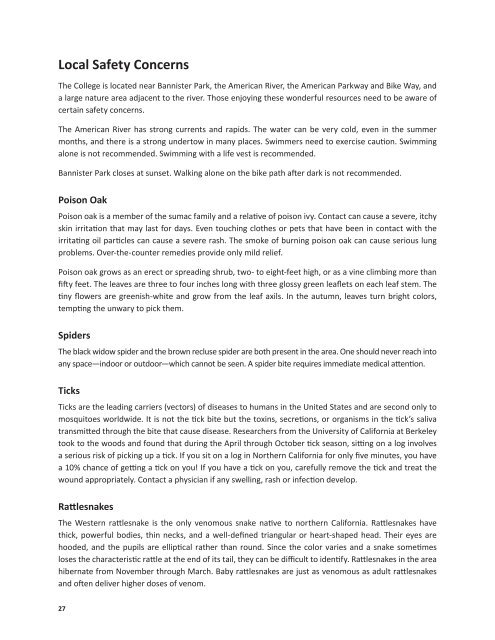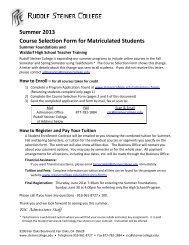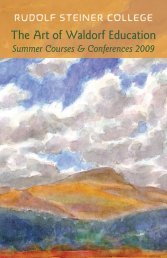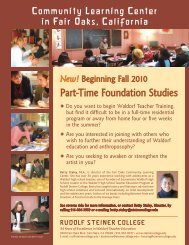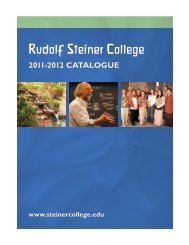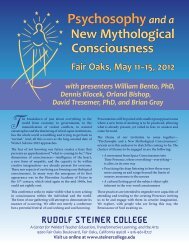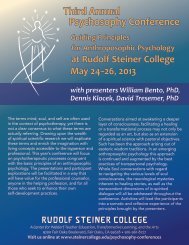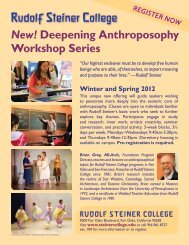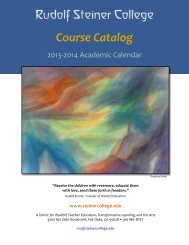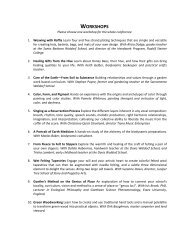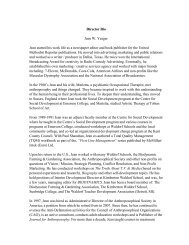Student Handbook - Rudolf Steiner College
Student Handbook - Rudolf Steiner College
Student Handbook - Rudolf Steiner College
Create successful ePaper yourself
Turn your PDF publications into a flip-book with our unique Google optimized e-Paper software.
Local Safety Concerns<br />
The <strong>College</strong> is located near Bannister Park, the American River, the American Parkway and Bike Way, and<br />
a large nature area adjacent to the river. Those enjoying these wonderful resources need to be aware of<br />
certain safety concerns.<br />
The American River has strong currents and rapids. The water can be very cold, even in the summer<br />
months, and there is a strong undertow in many places. Swimmers need to exercise caution. Swimming<br />
alone is not recommended. Swimming with a life vest is recommended.<br />
Bannister Park closes at sunset. Walking alone on the bike path after dark is not recommended.<br />
Poison Oak<br />
Poison oak is a member of the sumac family and a relative of poison ivy. Contact can cause a severe, itchy<br />
skin irritation that may last for days. Even touching clothes or pets that have been in contact with the<br />
irritating oil particles can cause a severe rash. The smoke of burning poison oak can cause serious lung<br />
problems. Over-the-counter remedies provide only mild relief.<br />
Poison oak grows as an erect or spreading shrub, two- to eight-feet high, or as a vine climbing more than<br />
fifty feet. The leaves are three to four inches long with three glossy green leaflets on each leaf stem. The<br />
tiny flowers are greenish-white and grow from the leaf axils. In the autumn, leaves turn bright colors,<br />
tempting the unwary to pick them.<br />
Spiders<br />
The black widow spider and the brown recluse spider are both present in the area. One should never reach into<br />
any space—indoor or outdoor—which cannot be seen. A spider bite requires immediate medical attention.<br />
Ticks<br />
Ticks are the leading carriers (vectors) of diseases to humans in the United States and are second only to<br />
mosquitoes worldwide. It is not the tick bite but the toxins, secretions, or organisms in the tick’s saliva<br />
transmitted through the bite that cause disease. Researchers from the University of California at Berkeley<br />
took to the woods and found that during the April through October tick season, sitting on a log involves<br />
a serious risk of picking up a tick. If you sit on a log in Northern California for only five minutes, you have<br />
a 10% chance of getting a tick on you! If you have a tick on you, carefully remove the tick and treat the<br />
wound appropriately. Contact a physician if any swelling, rash or infection develop.<br />
Rattlesnakes<br />
The Western rattlesnake is the only venomous snake native to northern California. Rattlesnakes have<br />
thick, powerful bodies, thin necks, and a well-defined triangular or heart-shaped head. Their eyes are<br />
hooded, and the pupils are elliptical rather than round. Since the color varies and a snake sometimes<br />
loses the characteristic rattle at the end of its tail, they can be difficult to identify. Rattlesnakes in the area<br />
hibernate from November through March. Baby rattlesnakes are just as venomous as adult rattlesnakes<br />
and often deliver higher doses of venom.<br />
27


